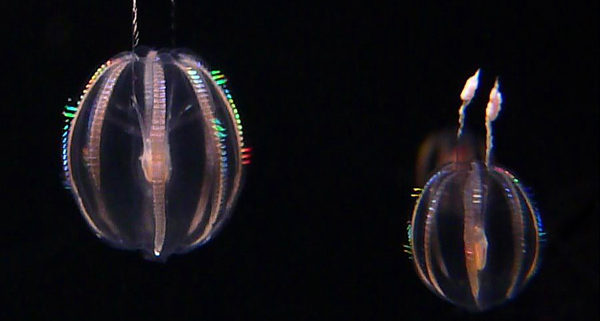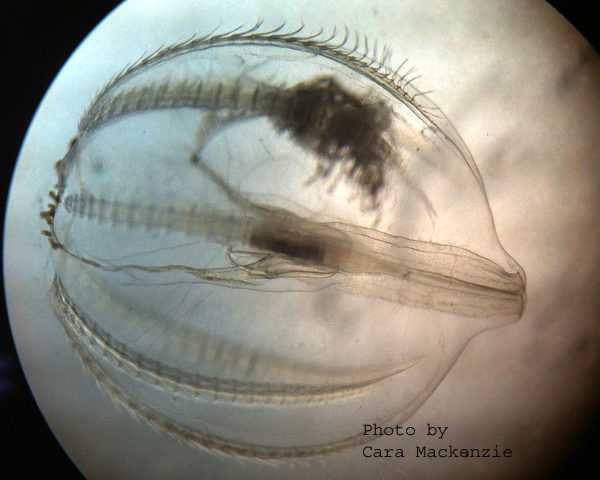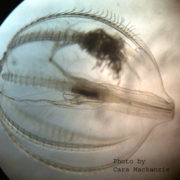Sea Gooseberry
Author: Max Newell and Marlo Osborne-Subasic
Common name: Sea Gooseberry
Scientific name: Pleurobrachia bachei
Size range: Up to 15 mm
Identifying Features
Pleurobrachia bachei are the most common comb jelly in the Victoria region. They are transparent and nearly spherical. Extending across the entire circumference you will find eight comb-rows evenly spaced. Comb-rows are made up of rows of comb-like cilia which are used for locomotion; they also refract light in a way that causes the gooseberry to shimmer with multiple colours all over its body. This species has two long tentacles (around 14cm in length) that come out from short tentacle bulbs that are pressed up against each side of the pharynx. These tentacles have smaller tentillum coming off of them which makes them resemble a feather when they are fully extended. When P. bachei is hunting the long tentacles are extended and dragged behind but they can be fully retracted into the tentacle bulbs if it is disturbed. They are made up of 99% water and, similar to other gooseberries, are biradially symmetrical. They can be found in large swarms particularly during warm summer months in sheltered bays.
Habitat
Pleurobrachia bachei have been seen as far north as Alaska and as far south as Acapulco, Mexico. Sea Gooseberries are pelagic and are frequently found in water close to shores. Different species can be found all over the world and may occur in shallow waters as well as in deep oceans. During the summer months along the west coast of North America P. bacheican be found in large swams and some individuals can become trapped within rock pools when the tide is falling.
Life Cycle
All gooseberries are hermaphrodites and reproduce sexually. Fertilization takes place externally and the resulting larvae (known as cydippid larva) are free swimming. Most gooseberries die after spawning. The Sea Gooseberry is planktonic its entire life, and there is no sessile stage. Once a larva has become a fully grown gooseberry, it is capable of releasing up to 1000 eggs per day. Gametes are released into the ocean via the gonopores, located on the comb-rows. The average lifespan of the Sea Gooseberry is 4.6 Months (140.01 days).
Food (Prey)
P. bachei hunt by extending their two long tentacles behind them and swimming through the water column. As the tentacles touch their prey, they become stuck to the specialized sticky cells on the tentacles called “colloblasts”. Once the prey is stuck, the gooseberry spins to wrap its tentacles around itself so that it can take the food trapped in its tentacles into its mouth. The P. bachei kept in our school aquarium feed upon newly hatched live brine shrimp (Artemia sp.). Unlike P. bachei, other gooseberry species such as the Beroid Gooseberry (Beroe abbysicola) are aggressive ambush predators that hunt without using tentacles. They primarily eat copepods and krill, but also eat fish eggs, mollusks, small crustaceans, larvae, and even other gooseberries.
Predators
The P. bachei is often preyed upon by large jellyfish such as Aurelia aurita and A. labiata. It is also eaten by fish like salmon and sometimes sea turtles. They can only escape from predators by beating the cilia in their comb-rows, and are the largest animals in the world to move through the use of cilia.
Video 1 by D. Young
Video 2 “Sea Gooseberry – close up” by Saidi, Hanna and Marijke
photos by D. Young and Cara Mackenzie
References
Rusnic24 (February 28th, 2011). Pleurobrachia bachei. Evergreen. Retrieved, December 19th2012 from http://wikis.evergreen.edu/marinelifeloll/index.php/Pleurobrachia_bachei
Niles C. Nara (1999) Pleurobrachia bachei “Gooseberry of the Sea” (Comb Jellies). Evergreen. Retrieved January 21st from http://academic.evergreen.edu/t/thuesene/animalia/ctenophora/bachei.html
Sea Gooseberry. ARKive. Retrieved December 7th 2012 from http://www.arkive.org/sea-gooseberry/pleurobrachia-pileus/
Widmer L. Chad (2008). How to keep jellyfish in aquariums. Tucson, Arizona 85705 U.S.A.: Wheatmark.
Wrobel, David and Mills, Claudia (1998). Pacific coast pelagic invertebrates: A guide to the common gelatinous animals. Monterey, California: Monterey bay aquarium.







Leave a Reply
Want to join the discussion?Feel free to contribute!